
Do you have a question about the Parker Calzoni MR Series and is the answer not in the manual?
Explains the manual's objective and the types of hydraulic motors covered.
Highlights general safety precautions when operating industrial machinery.
Defines the role and responsibilities of an operator.
Defines the role and responsibilities of a maintenance technician.
Explains the meaning of various symbols used in the documentation.
Details notes concerning ATEX standards for motors in explosive hazardous zones.
Lists additional documentation available upon request.
Explains how to identify the motor using its code and serial number.
Provides instructions for requesting technical support.
Outlines the manufacturer's responsibilities and limitations.
Provides a detailed description of the radial piston hydraulic motors.
Details conformity to ATEX 94/9/CE essential safety requirements.
Discusses the importance of viscosity, quality, and cleanliness of operating fluids.
Explains boost pressure requirements when the motor is used as a pump.
Specifies the recommended viscosity range for motor operation.
Lists limitations for extreme operating conditions regarding fluid viscosity.
Guides on selecting fluid based on operating temperature.
Details the types of hydraulic fluids that are allowed for use.
Specifies the required fluid filtration classes for smooth motor operation.
Warns against mixing different types of oils due to potential damage.
Describes the conditions in which motors are supplied.
Provides guidance on transporting the motors.
Gives recommendations for storing the motors.
Details the procedure for removing motor packaging.
Instructs on checking received material against shipping documents.
Provides procedures for handling motors during assembly and disassembly.
Details lifting methods for specific motor types using belts or tools.
Details lifting methods for MRT/MRTE/MTF/MRTA motor types using eyebolts.
Guides on mounting the motor to the machine/system and bolt tightening.
Explains how to make hydraulic connections for the motor.
Details connecting main inlet hoses to the motor ports.
Provides instructions for connecting the drain line.
Explains the purpose and methods of motor case flushing.
Details connections for displacement change on specific motor types.
Lists essential checks before the initial motor start-up.
Provides instructions and volume for filling the motor case with oil.
Details the procedure for starting up the motor and initial checks.
Provides a checklist for motors operating in explosive hazardous atmospheres.
Outlines periodic maintenance tasks for the hydraulic system.
Describes essential maintenance activities for the motor.
Details the process for cleaning or replacing filters.
Explains the scheduling and procedure for changing the operating fluid.
Advises verifying fluid viscosity levels.
Discusses oil oxidation and its detection.
Explains how to detect and the importance of removing water.
Addresses the importance of identifying and eliminating contamination sources.
Provides instructions for emptying the motor case.
Gives general information on repair and service procedures.
Offers guidance on troubleshooting common malfunctions.
Details the warranty conditions for the motors.
Provides instructions for safely shutting down and dismantling the motor.
Highlights safety precautions during dismantling.
Gives specific instructions for dismantling and material separation.